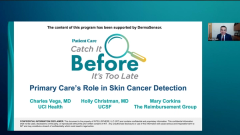
Integrating AI in Practice: The Future of Skin Checks
Panelists discuss the challenges of skin cancer evaluations, highlighting patient fears, systemic access barriers, and provider concerns about overreferral, while emphasizing the importance of clear communication, responsible resource use, and cautious adoption of emerging tools such as artificial intelligence (AI), with clinical judgment and trusted educational resources remaining central to care.
Episodes in this series

When discussing skin cancer evaluations with patients, providers often encounter a variety of concerns, with the most common being fear of a cancer diagnosis. This anxiety can shape how patients approach care, with some downplaying the seriousness of lesions or seeking immediate removal without fully understanding the implications. Long wait times to see a dermatologist and discomfort with the evaluation process are also significant barriers. These concerns are compounded by systemic issues such as limited access, cost, or lack of insurance, which affect patients’ willingness or ability to follow through on referrals or biopsies.
From the providers’ side, there’s also a need to manage expectations and resources wisely. While some patients may be eager to remove a lesion "just to be safe," clinicians must weigh that against the capacity of dermatology specialists and the overall health care system. Many primary care clinicians express hesitation about overreferring, especially when their diagnostic confidence is moderate. Tools such as dermoscopy can aid evaluation, but require specialized training and regular use—skills that not all primary care providers have the time or volume to develop. Even among dermatologists, dermatoscope usage varies significantly.
Technology and AI-based tools are beginning to enter this space, but they’re not yet mature or reliable enough for widespread clinical dependence. Many image-based AI apps are inconsistently trained or unintentionally biased, with studies showing they may learn from irrelevant markers rather than the lesion itself. Instead, providers are encouraged to use vetted educational resources such as DermNet NZ or the UK’s Primary Care Dermatology Society site for reference. The potential of AI is undeniable, but until these tools are thoroughly validated, experienced clinical judgment—combined with careful follow-up, patient communication, and when appropriate, in-house biopsy—remains the most trusted path forward.
Newsletter
Enhance your clinical practice with the Patient Care newsletter, offering the latest evidence-based guidelines, diagnostic insights, and treatment strategies for primary care physicians.













































































































































































































































































